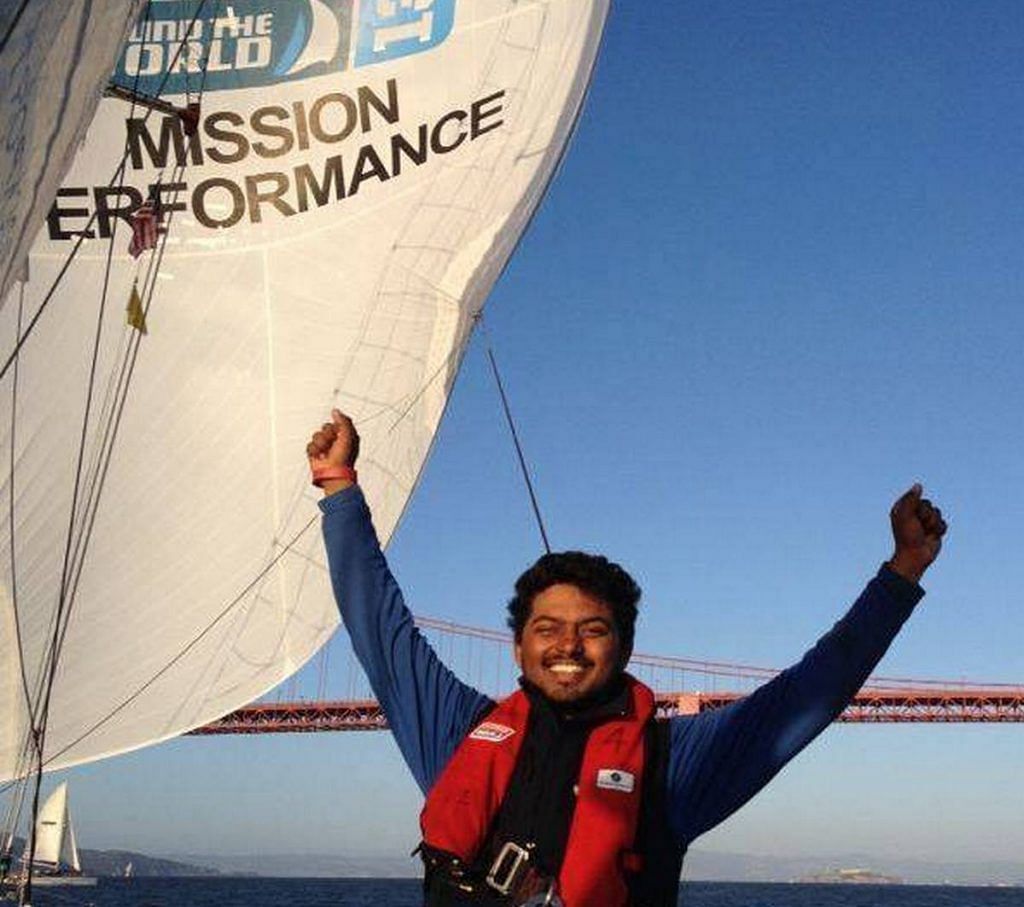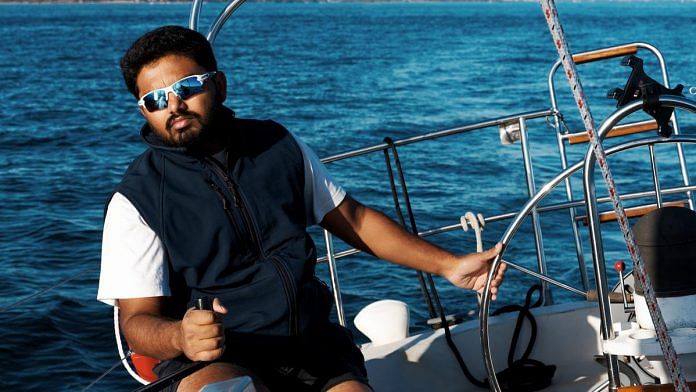New Delhi: When sailor Gaurav Shinde, 35, watched Nagaraj Manjule’s March 2022 release Jhund, he felt a tug of recognition. In the film, which is based on a true story, Amitabh Bachchan plays Vijay Barse, a social worker who founded the NGO Slum Soccer to give underprivileged children in Mumbai a leg-up through sport.
Shinde, now a Canadian citizen and management professional, specialises in what he calls a “rich man’s sport” — yachting — but there was a time when he too was just a Mumbai boy with limited funds but boundless dreams to become a role model for his Dalit community. As he put it in a tweet, “Jhund is my story.”
#jhund is my story and that of my friends. We all came from different parts of Mumbai without knowing what sailing is, into this rich man’s sport. It changed the trajectory of our lives and most of my friends are doing well. Without sailing we’d not gotten anywhere
— Gaurav Shindé (@sailorshinde) March 8, 2022
Paying a Rs 100 annual fee, he learned how to sail when he was 11, with some generous help from sailing masters, but establishing himself as an international great has proved to be little more complicated, especially during his quest to compete in the prestigious — and dangerous— Golden Globe Race.
Shinde has already invested everything he has in this race.
Speaking to ThePrint, he said: “This is a rich man’s game and people who belong to middle-class families obviously cannot self-sponsor a million dollars. After selling my house and through my savings, I have managed to raise some funds. I want this recognition for my community and I am willing to make these sacrifices.”
Shinde will embark on his journey from Les Sables-d’Olonne in France this September, but the Golden Globe Race is not like any other yachting competition. Competitors must not only circumnavigate the world completely alone, they also cannot use any modern technology — specifically, nothing that was invented after 1968, not even a mobile phone or iPod. The epic 30,000-mile (over 48,000 km) journey can take anywhere from 200 to 350 days.
It’s as tough as it sounds. In the 2018 Golden Globe Race, former Navy commander Abhilash Tomy had to be rescued from the Indian Ocean after about 150 days at sea when his yacht’s mast broke and he suffered a serious injury. In the 2018 edition, only five out of 18 sailors managed to finish the race.
Undeterred by such tales, Shinde is busy preparing himself and his boat Good Hope for the race but he has already encountered stormy weather.
Also Read: Ambedkar, Bachchan, caste, sport — Nagraj Manjule’s ‘Jhund’ says a lot by saying nothing at all
Golden Globe Race: Retro-sailing with a modern price tag
Competing in the Golden Globe requires not just sailing prowess but also solid financial backing.
To be eligible, sailors have to demonstrate that they have had sailing experience of at least 8,000 miles (nearly 13,000 km). Apart from this, they must have a minimum of 2,000 miles (approx. 3,200 km) of solo seafaring under their belt, and another 2,000 miles using only celestial navigation in the boat they propose to use for the race.
Applicants must pay an entry fee of AU$16,000 (approx. Rs 8.96 lakh) and carry £5 million (Rs 50.04 crore) in public liability insurance. No more than 25 sailors can make the cut each year, although five additional participants may join by special invitation.
This year, 24 sailors have qualified, including Shinde. “Until we get to the start and the boat is approved for safety, though, we’ll be provisional entries,” he explained.
Competing in this race is expensive business, especially considering that participants cannot do anything but sail for close to a year. To meet costs, many competitors seek sponsorship for their quest, although it isn’t always easy, as Shinde attested earlier.
The next hurdle, of course, is the race itself. The Golden Globe Race today holds homage to British sailor Sir Robin Knox-Johnston, who in 1968 became the first person to sail solo around the world non-stop in the first edition of the competition. Modern-day participants are expected to complete the feat under almost exactly the same conditions that he did.
To navigate, sailors have to use an old-school sextant to determine longitude and latitude and communicate via radio. Stopping at a port for any reason whatsoever means immediate disqualification. At the end of the race, competition authorities scrutinise ship logs and celestial navigation notes to check whether participants complied with the rules.
Shinde told ThePrint that he is equipped to deal with all these terms and conditions.
“With more than 20,000 nautical miles of ocean racing experience, I think this will be the ultimate test of my seamanship and I want to win this at any cost,” he said.
According to him, this race cleaned him out financially, but it was still within reach unlike other competitions.
“This is the only race I can afford to join since the others require deep pockets. More technology also means more money. I am managing this race after selling my house and with my limited savings,” he added.
The prize, incidentally is only £5,000 (approx. Rs 5 lakh), as in 1968, with no adjustment for inflation. The rules also say that any prizes are subject to the participants receiving sponsorship. The prestige of coming ahead in the race, though, is priceless for many sailors.

‘A lot is at stake’
Gaurav Shinde is currently rebuilding his boat to equip it for the final day. He bought his 34-foot Ta Shing Flying Dutchman/Baba 35 cutter from a New York-based owner who solid it to him for half the going price, he said. This benefactor also helped Shinde with an interest-free loan for his entry into the race.
“I received some help from the people who believed in me. Sailing is not a popular sport so to raise money through the Indian diaspora abroad was not really an option because they don’t fully understand what exactly racing entails,” Shinde said.
Back in India, too, getting sponsorships was a huge problem, as was getting due recognition for his achievements.
“There were times when I was not even invited for the ceremonies where I won awards. They used to send my awards through peons who came to drop them at railway stations. But I want to go past those challenges… despite them, I think I am the right person for this race, I want to beat the best record and to leave a mark,” he said.
A long journey, from Nashik to Canada
Gaurav Shinde’s roots are in Nashik, Maharashtra, but he spent much of his childhood in Mumbai, where he discovered his love of sailing at the Sea Cadet Corps training ship Jawahar. Training here cost only Rs 100 a year.
“I was 11 years old when I first tried sailing and I fell in love with it. Coming from a Bahujan community I always wanted to make a mark in the world so that there are some footsteps to follow for children who grew up just like me,” Shinde said.
His efforts went on to bring him recognition in sailing circles, especially for his performance in endurance events. He completed the 2013-14 Clipper Round the World Yacht Race and in 2014 won the Yachting Association of India’s Admiral Ramdas Trophy for ‘Offshore Adventurer of the Year’ — he was the first civilian to receive the award, which sailing leading lights like Abhilash Tomy and Dilip Donde have won before.
However, for a while, sailing took a backseat. In 2015, Shinde focused on finishing his MBA from the Ivey Business School in Canada and on his professional career, which included stints at Google and 3M.
He never forgot about sailing, though, and hopes that the Golden Globe Race will be his opportunity to hit the international big league.
(Edited by Asavari Singh)
Also Read: India must think beyond glory of medal winners. Many things still holding us back in sports



